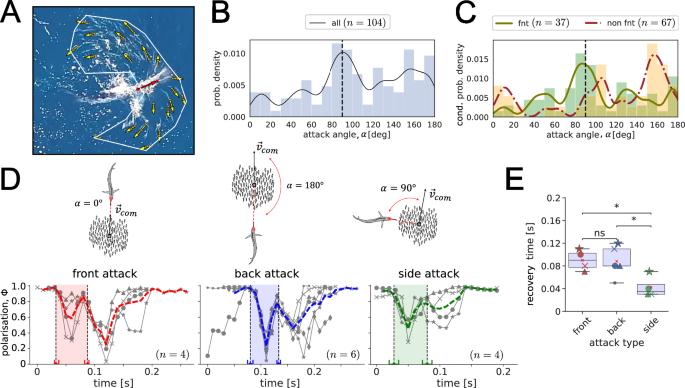Collective anti-predator escape manoeuvres through optimal attack and avoidance strategies
IF 5.2
1区 生物学
Q1 BIOLOGY
引用次数: 0
Abstract
The collective dynamics of self-organised systems emerge from the decision rules agents use to respond to each other and to external forces. This is evident in groups of animals under attack from predators, where understanding collective escape patterns requires evaluating the risks and rewards associated with particular social rules, prey escape behaviour, and predator attack strategies. Here, we find that the emergence of the ‘fountain effect’, a common collective pattern observed when animal groups evade predators, is the outcome of rules designed to maximise individual survival chances given predator hunting decisions. Using drone-based empirical observations of schooling sardine prey (Sardinops sagax caerulea) attacked by striped marlin (Kajikia audax), we first find the majority of attacks produce fountain effects, with the dynamics of these escapes dependent on the predator’s attack direction. Then, using a spatially-explicit agent-based model of predator-prey dynamics, we show that fountain manoeuvres can emerge from combining an optimal individual prey escape angle with social interactions. The escape rule appears to prioritise maximising the distance to the predator and creates conflict in the effectiveness of predators’ attacks and the prey’s avoidance, explaining the empirically observed predators’ attack strategies and the fountain evasions produced by prey. Overall, we identify the proximate and ultimate explanations for fountain effects and more generally highlight that the collective patterns of self-organised predatory-prey systems can be understood by considering both social escape rules and attack strategies. Agent-based modeling and observations of sardine schools evading marlin in the open ocean reveal that the “fountain effect” arises from prey optimizing escape angles to enhance survival, while predators exploit this to increase their hunting success.

通过优化攻击和规避策略集体反捕食者逃生。
自组织系统的集体动力来自于行为主体用来回应彼此和外部力量的决策规则。这在遭受捕食者攻击的动物群体中表现得非常明显,要理解集体逃逸模式,就必须评估与特定社会规则、猎物逃逸行为和捕食者攻击策略相关的风险和回报。在这里,我们发现 "喷泉效应 "的出现--动物群体躲避捕食者时常见的集体模式--是在捕食者狩猎决策下旨在最大化个体生存机会的规则的结果。利用无人机对条纹马林鱼(Kajikia audax)攻击正在游弋的沙丁鱼猎物(Sardinops sagax caerulea)的实证观察,我们首先发现大多数攻击都会产生喷泉效应,这些逃逸的动态取决于捕食者的攻击方向。然后,利用基于空间显式代理的捕食者-猎物动力学模型,我们表明喷泉机动可以通过将个体猎物的最佳逃逸角度与社会互动相结合而产生。逃逸规则似乎优先考虑最大化与捕食者的距离,并在捕食者的攻击和猎物的回避效果之间产生冲突,从而解释了经验观察到的捕食者的攻击策略和猎物的喷泉回避。总之,我们确定了喷泉效应的近似和最终解释,并从更广泛的角度强调,可以通过考虑社会逃避规则和攻击策略来理解自组织捕食-猎物系统的集体模式。
本文章由计算机程序翻译,如有差异,请以英文原文为准。
求助全文
约1分钟内获得全文
求助全文
来源期刊

Communications Biology
Medicine-Medicine (miscellaneous)
CiteScore
8.60
自引率
1.70%
发文量
1233
审稿时长
13 weeks
期刊介绍:
Communications Biology is an open access journal from Nature Research publishing high-quality research, reviews and commentary in all areas of the biological sciences. Research papers published by the journal represent significant advances bringing new biological insight to a specialized area of research.
 求助内容:
求助内容: 应助结果提醒方式:
应助结果提醒方式:


